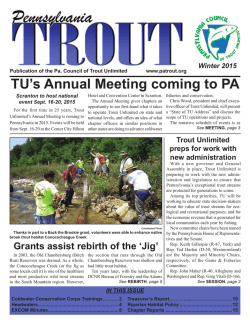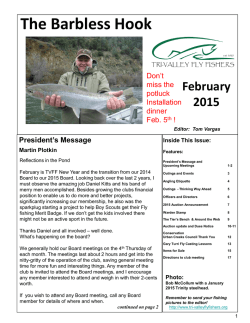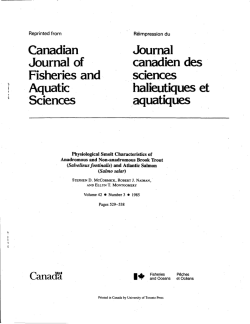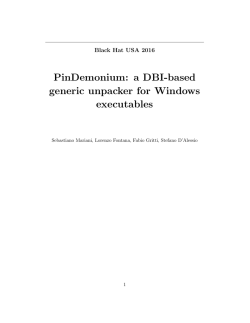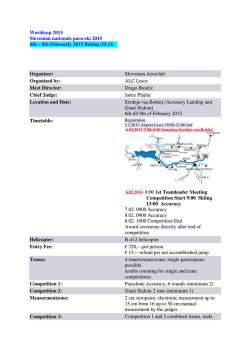
1) Feb Lateral Lines 2015 - Winchester Trout Unlimited #638
Page 1 of 13 Lateral Lines The Monthl y Newsletter of Winchester Trout Unlimited Recognized as VCTU’s best newsletter in 2014 Recipient of the 2013 Bollinger Award as TU's Finest Newsletter Chapter #638 February 2015 Next meeting is Thursday, February 5, 2015 5:30 p.m. Dinner IJ Cann’s 7:00 p.m. Meeting See you at the meeting on Thursday, January 8, 2015 Bill Prokopchak, Newsletter Editor 540-722-2620 Volume 20, Number 2 In This Edition Bud on the Run: Redbud Run ------------- Page 1 On the Fly: The Para Midge Dun ---------- Page 3 Project Healing Waters: Martinsburg --- Page 6 The Poet’s Corner: “Night Fishing” ---- Page 4 NW Works 3085 Shawnee Drive Winchester Shenandoah Audubon ------------------------ Page 7 The Well-Schooled Angler ------------------ Page 8 Our next TU workday is 10:00 a.m., Saturday, February 7 at Redbud Run. Fish Need Leaves ----------------------------- Page 9 2015 Tri-State Fishing Camp --------------- Page 12 Winchester TU 2015 Schedule ------------ Page 13 Bud on the Run: Redbud Run by Bud Nagelvoort Next Work Session: Saturday, February 7th at Redbud Run Saturday, January 10, 10:00 a.m. - 1 p.m., began an attack on bank erosion and related siltation problems at Redbud Run on Wayne Seiple’s property. Wayne owns almost a mile of stream immediately upstream from the mile of stream secured with Winchester TU help for the Department of Game and Inland Fisheries and now protected by “artificials only, catch-and-release designation”. Nativised Kamloops rainbows and beginnings of restored native brook trout are the prize species here. As you will recall, Winchester TU members conducted measurements of silt depths to bed rock in the first 1000 feet upstream from the Morgans Mill Road bridge last fall to help determine where problems exist and enhancement installations might occur. Subsequently Seth Coffman and local TU members took a hard look at several locations where fallen trees are deflecting flow into vertical banks. A fallen tree has diverted the flow of Redbud Run, causing bank erosion. Photo by Bud Nagelvoort Seth is National TU’s rep in the Valley whose latest effort in our vicinity has been a major project on Spout Run in Clarke County where 600 feet of channel have been protected with the tapering of vertical banks and establishment of vegetated flood plain to absorb sediments carried by flood flows. “Bud on the Run” continues on the next page. Page 2 of 13 Bud on the Run: Chapel Run -- continued article by Bud Nagelvoort Old hands with Chapel Run experience including Dave Vanbenschoten, Terry Lay, Lisa LaCivata, and yours truly along with newcomer Gene Lewis (manager of Shenandoah University’s new project and facilities at Cool Spring on the main stem of the Shenandoah River) and Wayne Seipel himself made up the Redbud Run work crew. Half the crew worked on a giant silver maple blocking the stream, contributing to the creation of an island, and diverting flows into two new bank-eroding channels. The other half of the work crew began the process of clearing the debris collection at the head of the island. Much of the work on the silver maple involved removing most of the limbs and dragging them with chain and cable with the old reliable Takoma up the bank to level ground. Much of the jam at the head of the island also now resides on high ground. The work crew cut and hauled the downed silver maple that diverted the flow and caused extensive bank erosion. Photo by Lisa LaCivita Substantially more work is required to block the side channels and re-create the old mid-stream channel through the island. Initial discussions indicate much big rock will be needed within log structures to assure survival of the new channel. Anyone know where there is some big rock? Bud and Gene plan for flood debris removal at Redbud Run. Photo by Lisa LaCivita Gene, Terry, Wayne, and Dave take a break from their stream restoration labors with Bud’s old Tacoma pick-up truck. Missing from the photo is Lisa. Photo by Bud Nagelvoort We have yet to reach Miss811 to get a final determination on the cross-stream pipe at the foot of the island. Will take care of a request for that on January 26. Before the next work session, now scheduled for Feb. 7, we’ll draw up the design for the structure to divert the south channel into the buried old mid-stream channel. On February 7, we’ll hope winter has relented some and the flow is not overly influenced by snow melt or climate change downpours. If we have a good-sized work crew because no one overindulges the evening of February 6, some will get the structure underway while others attack the island with shovels, prybars, and maybe a cofferdam of sorts. In the meantime, with access to the rock source unencumbered by snow and ice there should be the beginning of quantities of 50 pounders to place within the log structure to shore up the south bank. Plans for the north bank will follow. Stay tuned. Page 3 of 13 On the Fly: The Para Midge Dun article and photos by Carl A. Rettenberger By now, most of you have tied or at least fished my “Red Midge Emerger”. Which by the way as I mentioned before, I never fish as a true emerger, but rather I recommend fishing it as the point fly with a size-8 split shot about 12 inches above it, that way the fly will stay submerged in the water column where it is free to wiggle and drive the fish crazy. Well, since I have had so much luck with this emerger, I’ve been struggling to create a dry fly version that will work equally well, and I’ve finally done it. I decided to call this new fly my “Para Midge Dun” for reasons which will become apparent as we tie the fly. This fly features something new, or at least something different that I haven’t described before, and that is a “Parachute Hackle”. At first, it may appear difficult to tie a “Parachute Hackle”, but like with everything else, it becomes easier with practice. That said let’s get on with the tying. Lateral view Para Midge Dun List of Materials: Hook: TMC 2487 size 10 to 18 Thread: Uni-thread size 8/0, color: red (black works for Black Fly Para Duns) Body: Red thread 8/0. Thread wraps must form a slim, smooth body. Tail: CDC Oiler Puffs (color: white) Rib: Fine silver wire Post: Poly Yarn, color: white (or to suit your tastes) Wing: Grizzled Cock Hackle, tied parachute style Thorax: Peacock herl Tying Instructions: 1. After bending down the barb of the hook, mount the hook in the vice such that the tips of the jaws grip the hook at the lower side of the bend as shown in the above picture. 2. Now, wrap the hook shank with close booking thread wraps from the shoulder of the eye down to just beyond the bend of the hook shank. 3. Tie in a tail (on top of the hook shank), consisting of one CDC Oiler Puff feather. The tail wants to be no more than three to four millimeters long. I like to pick off the ends extending past the bend of the hook to shorten them rather than cutting them straight with scissors. Tidy up the tie in by crushing the stem of the CDC feather with your thumbnail so that it lies flat on top of the hook shank and wrap the thread forward to within three or four millimeters from the eye of the hook with close booking wraps. Park the thread there. Something to ponder!! "I have many loves and Fly-Fishing is one of them; it brings peace and harmony to my being, which I can then pass on to others." Sue Kreutzer Carl’s recipe for “The Para Midge Dun” continues on the next page. Page 4 of 13 On the Fly: The Para Midge Dun -- continued article and photos by Carl A. Rettenberger 4. Tie in the wire rib material where the thread is parked. Extend the wire up along the “top” of the hook shank towards the bend of the hook and wrap it down with tight close booking thread wraps to the last thread wrap at the CDC tail material. Twist off the waste end of the wire at the tie in point behind the eye of the hook, then wrap the thread forward to the point where you just twisted off the wire. The most important thing to remember is that you need to keep the thread wraps tight, in close booking turns forming a smooth uniform body, don’t allow gaps in the thread wraps. Now, spiral wrap the wire up along the hook shank to where the thread is parked, tie it off and twist off the tag. Don’t get the wire spirals wraps too close together, but rather try to keep them evenly spaced about two or three millimeters apart. 5. Next, wrap the thread back to a point half way between the shoulder of the eye and the point of the hook and park it there. The Post It’s now time to mount the post that will support the parachute hackle. To do this, start by cutting a piece of Poly Yarn from the hank that is about three or four inches long, and divide it so that you wind up with a piece that is about the thickness of a 2H pencil lead or slightly larger depending on the size of the hook. Next, center the Poly Yarn on top of the hook shank where the thread is parked and tie it in with several tight figureeight thread wraps. Now, to create the actual post that will support the parachute hackle, the two ends of the Poly Yarn are brought together straight up over the top of the hook shank and are then wrapped with tight booking thread wraps to a point about four millimeters above the top of the hook shank and then back down to the top of the hook shank. This is a “Gallows”; you can buy one or make one yourself, like I did. It’s just a wire clothes hanger, bent to shape and flattened on one end so that I could drill a small hole in it on which to hang a small spring and a dolls clothes pin. I’ll describe a method to tie this fly without a “Gallows”, but it’s a lot easier to tie if you have one. It helps to create the post if you have a Gallows (as shown above) to hold the ends of the Poly Yarn up and taut while you wrap the thread around it, but you can do it without one if you hold the ends of the Poly Yarn together tightly and straight up over the hook shank with your fingers as you make the first tight thread wrap around the post at the top of the hook shank. Now, release the Poly Yarn and make the next loose thread wrap around the post, do not pull on the bobbin after you make the loose wrap or you will pull the thread off the post. Recapture the ends of the post and tighten up on the thread wrap such that it is above and immediately adjacent (booking) to the previous wrap. Continue this procedure wrapping the thread up and back down the post. Park the thread at the top of the hook shank, immediately adjacent to the post on the bend side of the hook. You probably figured out by now that the purpose of this wrapping is to stiffen up the post where the hackle is to be wrapped. Carl’s recipe for “The Para Midge Dun” continues on the next page. Page 5 of 13 On the Fly: The Para Midge Dun -- continued article and photos by Carl A. Rettenberger 6. The next step is to select the proper size hackle to create the “Parachute Style Hackle”, which is wrapped horizontally around the post. The length of the “Standard Dry Fly Vertical Hackle” is usually one to one and a quarter times the hook gape for the given hook size. However, the length of a “Parachute Style Hackle” is slightly larger being one and a half to one and three quarters times the hook gape. After you have sized the hackle for the given hook size, strip the fluff from the bottom of the feather. The hackle stem needs to be flexible so you might need to strip off more fibers than usual until you have a flexible stem. Now, you must decide if you want to dress the fly with a “Light Parachute Hackle” to use in mild stream currents, or a “Heavy Parachute Hackle” to use in fast stream currents. I’ll describe the procedure for a “Heavy Parachute Hackle” first. For a “Heavy Parachute Hackle”, offer the bare stem of the hackle feather to your side of the post with the point of the hackle stem protruding out over the eye of the hook, and tie it in with a couple of loose thread wraps. Adjust the position of the hackle so that the bare stem is about one millimeter from the thread and tighten up on the thread wraps. Take a couple more tight thread wraps around the stem and hook shank then cross the thread over to the front of the post and tie the stem down with tight booking thread wraps to about a millimeter back of the shoulder of the eye of the hook. Trim off the waste hackle stem and tidy up the area in front of the post, parking the thread at the front side of the post. Dorsal view Para Midge Dun Now, grab the tip of the hackle feather with a small set of hackle pliers and wrap the hackle feather up and down the post in the same fashion as you did the thread used to create the post. The hackle needs to be wrapped in a booking manner up to the top of, and just cover the top thread wraps used to stiffen the post. Each hackle wrap must be tightened after each turn around the post. When you wrap down and reach the top of the hook shank pass the hackle pliers over the hook shank at the eye side of the post allowing it to hang there. Now, gently pull the post and wrapped hackle back towards the bend of the hook which will create space in the front of the post so that you can tie the hackle off with several tight thread wraps. Trim off the waste hackle, tidy up the area in the front of the post, then release the post and wrapped hackle. A gentle tug on the post will bring it and the hackle back to a vertical position. For a “Light Parachute Hackle” the bare hackle stem is wrapped up the post to the top of thread wrappings and then the hackle barbules are wrapped down to the top of the hook shank creating the horizontal style “Light Parachute Hackle”. 7. Next for a thorax, wrap the thread back to a point about three millimeters behind the post and tie in two or three Peacock herls with the waste end protruding out over the eye of the hook. To do this, capture the hackle and post between your fingers and gently pull them towards the eye of the hook as you wrap the herl down with tight thread wraps, to a point immediately against to the rear of the post. When the thread wraps reach the base of the post release the hackle and post and then recapture them and gently pull them towards the bend of the hook as you wrap the herl down with tight thread wraps to a point a millimeter or so behind the shoulder of the eye of the hook. Park the thread there and trim off the waste herl that is protruding out over the eye of the hook. Now, repeat this gentle pulling of the post and hackle procedure as you wrap the herl around the hook shank up to the rear of the post, then immediately adjacent to the front of the post, finishing at the point where the thread is parked. Now, tie down the herl and trim off the waste. 8. Form a nice thread head and cover it with several coats of varnish and your done tying. As a final step, check the post to make sure it’s perpendicular to the top of the hook shank and adjust it and the parachute hackle as necessary. If the hackle needs fluffing, you can hold the fly in a column of steam. That’s it, now take the Para Midge Dun to your favorite trout stream and give it a go!! Something to ponder!! "All men who fish may in turn be divided into two parts: those who fish for trout and those who don't. Trout fishermen are a race apart: they are a dedicated crew - indolent, improvident, and quietly mad." Robert Traver Page 6 of 13 Fly-tying Classes start this month! And other news... by Paul Wilson, PHW Program Leader, Martinsburg VAMC Our first class in 2015 will be a new one for us and the Martinsburg VA Medical Center. We will be teaching fly-tying in one of the hospital's Community Living Centers for Kelly Whipp's Recreation Program. The first fly-tying class will be on Thursday afternoon February 12th from 1:30 to 3:00 pm. This is a great opportunity as Kelly has already been taking her Veterans to the Leetown USGS pond for the Friday morning spinfishing. If there is interest among her patients, we will follow up the fly-tying with casting classes in the gym at a later date and then turn one of her Leetown fishing trips into a fly-fishing event. If you can volunteer on February 12th please contact me immediately! PLEASE VOLUNTEER! New PHW Project: Our TU/Sierra Club TFO reels are showing some line wear from multiple use in our PHW classes and fly-fishing outings. Rather than replace the lines and beat them up again at our classes, I suggest that our members donate used reels that are in good working condition which we will save for fishing events. If you want to donate a 5-wt. floating line, please do so. Donations of either a reel or line, or both, would really help and give us good reels with good lines that the veterans will use only for fishing trips. PLEASE DONATE! New Social Media: Thanks to the great work of our extraordinary Webmaster, Charlie Loudermilk, we now have a Project Healing Waters webpage on our TU chapter website. This is a general information page on our Program with a bit of history and contact info for our Program Leaders. Classes and outings are in our TU Chapter Calender, as well as on our new PHW Martinsburg website. The link is below so please check it out. We will be uploading pictures, class schedules and other information on both the TU chapter site and our PHW program site. This website was designed and uploaded by TU member and PHW co-leader, Kenny Hawthorne, with the help of his web-designer wife who is also working on a PHW phone App. Betcha no other chapter has one of these!! So, if you can volunteer for any of our Project Healing Waters fly-fishing events or classes, please contact me. Paul Wilson Program Lead Cell: 304-279-1361 Email: [email protected] Check out our new Website: http://www.healingwatersmartinsburg.org/ Like us on Facebook: https://www.facebook.com/ProjectHealingWatersOfMartinsburgWestVirginia Page 7 of 13 Poet’s Corner: Poems selected for the angler by Bud Nagelvoort Night Fishing from Small Talk by Peter Sears Oregon’s Poet Laureate learn more about Peter Sears at petersears.com The water is a glaze like loneliness at ease with itself. I cast and close my eyes for the whir out across the water, the line striking the surface and sinking. I like waiting for it to settle on the bottom, and then jig it up a little. I imagine the lure in the utter dark. I play it lightly. Fish rise. Just shy of the surface, they play their glints off the moon on the water. I see too my own loneliness. It’s not too big and it breathes easily. Soon, it may pretend it’s rain. Rain blurs the water. There is nothing wrong with rain. I take a deep breath and cast and cast. Photo by Bill Prokopchak Our sister conservation organizations, Shenandoah Audubon and Potomac Conservancy, invite Winchester TU members and Friends of the Shenandoah to join them on April 13th. Page 8 of 13 The Well-Schooled Angler Compiled by Barbara Gamble Wade and Shoreline Fishing the Potomac River for Smallmouth Bass, 2nd edition Author: Steve Moore Paperback: 208 pages ISBN-10: 0986100307 ISBN-13: 978-0986100307 Publisher: Calibrated Consulting, Inc. Publication Date: January 19, 2015 This edition adds one new access point and updates regulations impacting a number of others. Tying Heritage Featherwing Streamers Authors: Sharon E. Wright Paperback: 176 pages ISBN-13: 978-0811713580 Publisher: Stackpole Books Publication Date: January 15, 2015 Featherwing streamers reached the pinnacle of artistic and tying methodologies in the Rangeley region of Maine with the patterns of Carrie Stevens (1882-1953). Learn the mysteries of the Carrie Stevens method of making Rangeley-style streamers - one of the most enduring, effective, and beautiful baitfish imitations for catching trout. In this book, Steve shares his years of experience fishing one of the East Coast's best, yet most underrated, smallmouth rivers - the Upper Potomac. This book literally walks the reader 57 miles upstream starting at the Chain Bridge in the District of Columbia to end at Dam 3 above Harpers Ferry. Given a picture is worth 1,000 words, the book includes over 200 augmented with 42 maps and 45 tables of critical information allowing you to determine the right place to go and the right time to be there. Other Potomac books assume you have a boat; this one assumes you fish on your feet. Steve dedicates the entire book to guiding you to locations where you can wade or fish from the shore. It includes 33 named chapters discussing the major access points in Virginia, Maryland, and West Virginia. Many contain additional information on minor access points within the same area; expanding the total geographic coverage dramatically. This book is "internet aware" and includes 208 GPS coordinates usable in Google Maps for precise directions as well as to open the satellite view to obtain a birds-eye perspective. Kayak and canoe fishing enthusiasts will find this book to be equally useful. Steve is a regular columnist for Southern Trout Magazine where he writes the "New Fly Guy" column focused on helping new fly anglers with tips, techniques and other advice. Coming up on 63 years old, Steve is proud of the fact that he has been fishing for over half a century. Sources: Amazon.com, Barnesandnoble.com, and the publisher Proven techniques Full-color photos Practical tips for solving common tying problems Exclusive recipes from the author "Tying Heritage Featherwing Streamers is the first complete guide to creating some of the most beautiful and effective patterns in the history of fly fishing. Author Sharon E. Wright has written a book that is both useful and inspiring; read this book and you will be able to tie these flies. Every serious fly tier should add Tying Heritage Featherwing Streamers to his library."--American Angler magazine "Sharon E. Wright has left no stone unturned in her Tying Heritage Featherwing Streamers. The photography is simply breathtaking, the history is a pleasant read that enlightened me, and the list of patterns and tying steps could keep a tier busy forever. Not only is her tying table like an artist's canvas, colorful and meticulously organized, she loves to share her knowledge of tying. So now Sharon is an author. I'm so happy for her, because her effort in writing her book demonstrates the same attention to detail as her tying, her table displays at the shows, and her rapport with show customers. Tying Heritage Featherwing Streamers is definitely in an elite category of its own and a centerpiece in any person's library."--Chuck Furimsky, director, International Fly Tying Symposium Sources: Amazon.com, Barnesandnoble.com, and the publisher Page 9 of 13 Streamside forests are important links to healthy waterways and the fish that live there. Above, adult mayfly. © Harry Murray by Robert Whitescarver The sun set half an hour ago. The air thickens with moisture as fog slowly moves in over the river on its unceasing journey. The water riffling over the rocks is all I can hear. It takes me a few minutes to focus on the insects. There must be a hundred of them spinning up and down over the water. These are male mayflies swarming to mate with a female as she flies through their midst. When mayflies are pre - sent, it’s a good sign there will be fish. Fish, especially trout, like to eat mayflies. Anglers know well the importance of mayflies, caddisflies, stoneflies, crane flies, and other insects that spend most of their life in the water. Grouped together, these are called aquatic macroinvertebrates, which means that -- like other invertebrates -- they lack backbones, but are large enough to be seen by the naked eye. These insects are good indicators of clean water, which is necessary for many fish, including Virginia’s native brook trout, or brookie. Macroinvertebrates prefer different species of native leaves, like this sugar maple, on the left, and hickory leaf, on the right. © Robert Whitescarver The larval stages of these aquatic insects represent a primary food source for many species of fish. Macroinvertebrates spend the majority of their lives in the water. From the time the egg hatches through pupation, many of these insects spend most of their time eating leaves that have fallen into the stream. Scientists call these leaf eaters “shredders” because of their ability to shred and consume fallen leaves; they are the leaf digesters of the streams. When they have grown to full size, they will undergo metamorphosis to the winged stage. At this point, they move to the surface of the water and take flight, a phenomenon fondly awaited by anglers called a “hatch”. Anglers attempt to mimic insects that trout are eating, such as this “Quill Gordon” dry fly made to float on the water. © Robert Whitescarver Fly fishermen take great pride “tying flies” that mimic the insects they think the fish are eating. For example, Quill Gordon and March Brown flies mimic the mayflies in the Heptageniidae family. These mayflies are known as “clingers” because of their ability to hang onto rocks in fast-moving water. Above, a mayfly nymph © Ann and Rob Simpson Scientists at the Stroud Water Research Center in Avondale, Pennsylvania have been studying freshwater ecosystems since the 1960s. Dr. Bernard Sweeney is the director and senior research scientist at Stroud. He believes, “A streamside forest along headwater streams is the single most important component for a healthy aquatic ecosystem.” “Fish Need Leaves” continues on the next page. Page 10 of 13 Leaves from streamside forests serve as the main food source for macroinvertebrates. It’s the bottom of the food chain for trout and other fish. Put another way, it’s the corn silage of the fish farm: no leaves, no insects, no fish. Not only do trees supply food for the insects, they also provide shade, which keeps water temperatures cool and prevents intense sunlight from directly reaching the stream. Thus, Sweeney contends, the three most important factors in a healthy aquatic ecosystem are food, temperature, and light. A healthy mix of native trees along a stream bank supplies an abundance of food options for aquatic insects, which will attract and nurture fish. Temperature “Each macroinvertebrate species has an optimum temperature regime. One species of mayfly we studied flourished at 68° Fahrenheit but perished at 70°. Keeping water temperatures cool is absolutely critical for these insects. They live on the edge because just a few degrees warmer may be lethal,” the scientist insists. © Robert Whitescarver Left , indoor research flumes at the Stroud Water Research Center are used to find out what species of leaves different macroinvertebrates prefer to consume. Above, Dr. Bernard Sweeney, director of the research center, stands next to outdoor research flumes. © Robert Whitescarver Food “Even within a group of aquatic insects such as the mayflies and crane flies, species who eat leaves do so preferentially, clearly eating one species of leaf over another when given a choice, perhaps in recognition of the fact that each leaf species has different nutrient values,” explains Sweeney. Researchers with the Stroud Water Research Center have constructed both indoor and outdoor flumes to test which species of leaves each species of aquatic insect prefers. As depicted in this graph, giant crane fly larvae grew about two and a half times faster on hickory and maple leaves than on red oak leaves. Graph courtesy of the Stroud Water Research Center Sweeney stresses that since each aquatic insect prefers certain species of leaves over others and grows and survives differently on them as well, it is imperative to have a diversity of native trees along streams. Trout need cool temperatures as well. Brook trout thrive when water temperatures are in the 60s. They struggle and often perish when water temperatures climb to the 70s or higher. Trees along streams help keep water temperatures cooler by providing shade during the warmer months. According to Sweeney, on average, forested sections of streams receive 17 percent less radiation than nonforested segments. Light Sweeney and other scientists at Stroud confirmed that light intensity affects the types of algae that grow in a stream. He states in one research paper, “Algal photosynthesis is a linear function of light intensity.” In other words, the more light, the more algae. He further suggests that for trout and macro invertebrates, long filamentous algae (multiple celled), which favor intense light, do not make good habitat. Having plenty of trees along the stream will prevent intense light from reaching the water, thus favoring single celled algae such as diatoms -- the algae preferred by macroinvertebrates found in cleaner streams. Water Quality Dr. Tom Benzing is a Professor of Integrated Science and Technology at James Madison University and Vice President for Conservation on the Virginia State Council of Trout Unlimited. He says, “To bring back native brook trout we must improve water quality and restore habitat. Eliminating sediment sources in the water and planting native trees along streams will help trout and the entire aquatic ecosystem.” “Fish Need Leaves” continues on the next page. © Robert Whitescarver Page 11 of 13 Dr. Tom Benzing of Trout Unlimited has been a champion for research and conservation efforts to bring back native brook trout. Sediment congregates when soil is not protected from the forces of erosion. Exposed soil easily erodes from bare ground, construction sites, denuded ditches, and poorly managed farms. Livestock on those farms, especially cattle, devastate fish habitat when they are allowed unlimited access to streams. They not only pollute the water with manure and urine, they trample stream banks, cause further soil erosion, and prevent trees from growing along the banks. Paul Bugas, who serves as aquatics manager for the Department’s (DGIF) northcentral region, stresses this point. “Soil particles clog the gills of fish and smother populations of macroinvertebrates and fish eggs. Suspended soil particles create cloudy conditions, resulting in ecological damage. Unlimited access of cattle in streams absolutely destroys aquatic habitat,” he concurs. Brook trout need very clean water, as do mayflies. “You bring back the mayflies, you will bring back native trout,” says Benzing. To achieve this, we must plant native trees along the banks of our streams, prevent soil from washing off the land, and keep livestock out of our waterways. Virginia has a plan to bring back the mayflies and the trout: It’s called the Watershed Improvement Plan, and it calls for planting 103,552 acres of new streamside forests by 2025. This young “brookie” is the only trout native to Virginia and requires clean water to thrive. © Ralph Hensley Virginia and the U.S. Department of Agriculture have programs to help landowners install streamside forests, reduce soil erosion, and fence livestock out of streams. These programs reimburse land owners for the financial costs of planting trees, planting cover crops, healing eroded areas, and installing fences and livestock watering systems at rates ranging from 75 to 140 percent. One example, the Conservation Reserve Program, also pays rent on the land that is excluded from livestock -sometimes as much as $100 per acre per year. Help us achieve this goal by planting native trees along the streams on your property and encourage others to help as well. By working together we can bring back healthy waterways and Virginia’s coveted native trout, the spectacular brookie. Robert “Bobby”Whitescarver, president of Whitescarver Natural Resources Mgmt. and a farmer in Swoope, can be reached at: www.getting moreontheground.com. RESOURCES To find out how you can help plant more streamside forests, protect soil from eroding, and excluding livestock from streams contact: • Your local Soil and Water Conservation District: www.vaswcd.org • U.S. Department of Agriculture: www.usda.gov/ •Virginia Department of Forestry: www.dgif.virginia.gov Winchester Trout Unlimited thanks the author, Robert Whitescarver, for permission to include this article in our newsletter, LATERAL LINES. Page 12 of 13 Page 12 of 13 2015 Calendar of Events Winchester Trout Unlimited By Fred Boyer See the complete calendar of Winchester TU events at winchestertu.org February 2015 Thursday 5 Feb 2015 -- 7:00 p.m. - TU monthly meeting Saturday 7 Feb 2015 -- 9:00 a.m. - TU workday at a location to be announced Thursday 12 Feb 2015 -- 6:00 a.m. - Winter Brookie trip. Fred is coordinating Thursday 12 February 12 -- 1:30 to 3:00 p.m. - PHW fly-tying Class at the Martinsburg VA Medical Center. Paul Kearney is coordinating. Saturday 28 Feb 2015 -- 9:00 a.m. - 5:30 p.m. - Lancaster Fly-Fishing Show March 2015 Sunday 1 March 2015 -- 9:00 a.m. - 4:30 p.m. - Lancaster Fly-Fishing Show Thursday 5 March 2015 -- 7:00 p.m. - TU monthly meeting Saturday 7 March 2015 -- 9:00 a.m. - TU workday at a location to be announced TBA -- Spring Steelhead trip to Erie April 2015 Thursday 2 April 2015 -- 7:00 p.m. - TU monthly meeting Saturday 4 April 2015 -- 9:00 a.m. - TU workday at a location to be announced Monday 13 April 2015 -- 6:00 p.m. Bird Walk & 7:00 p.m. Riverside Habitat Preservation presentation by Shenandoah Audubon May 2015 Thursday 7 May 2015 -- 7:00 p.m. - TU monthly meeting Saturday 9 May 2015 -- 9:00 a.m. - TU workday at a location to be announced Tuesday 19 May to Thursday 21 May 2015 -- PA State College Trout Trip. Dan is coordinating June 2015 Thursday 4 June 2015 -- 7:00 p.m. - TU monthly meeting Saturday 6 June 2015 -- 9:00 a.m. - TU workday at a location to be announced Sunday 21 June through Friday 26 June 2015 -- Tri-State Conservation and Fishing Camp The opinions expressed in Lateral Lines are those of the individual authors and are not necessarily those of Winchester Trout Unlimited or Trout Unlimited National. All water sports, including fishing, have inherent dangers. Participation in all Winchester Trout Unlimited activities is at the participant’s own risk and participants agree to hold harmless Winchester Trout Unlimited and its members.
© Copyright 2025

